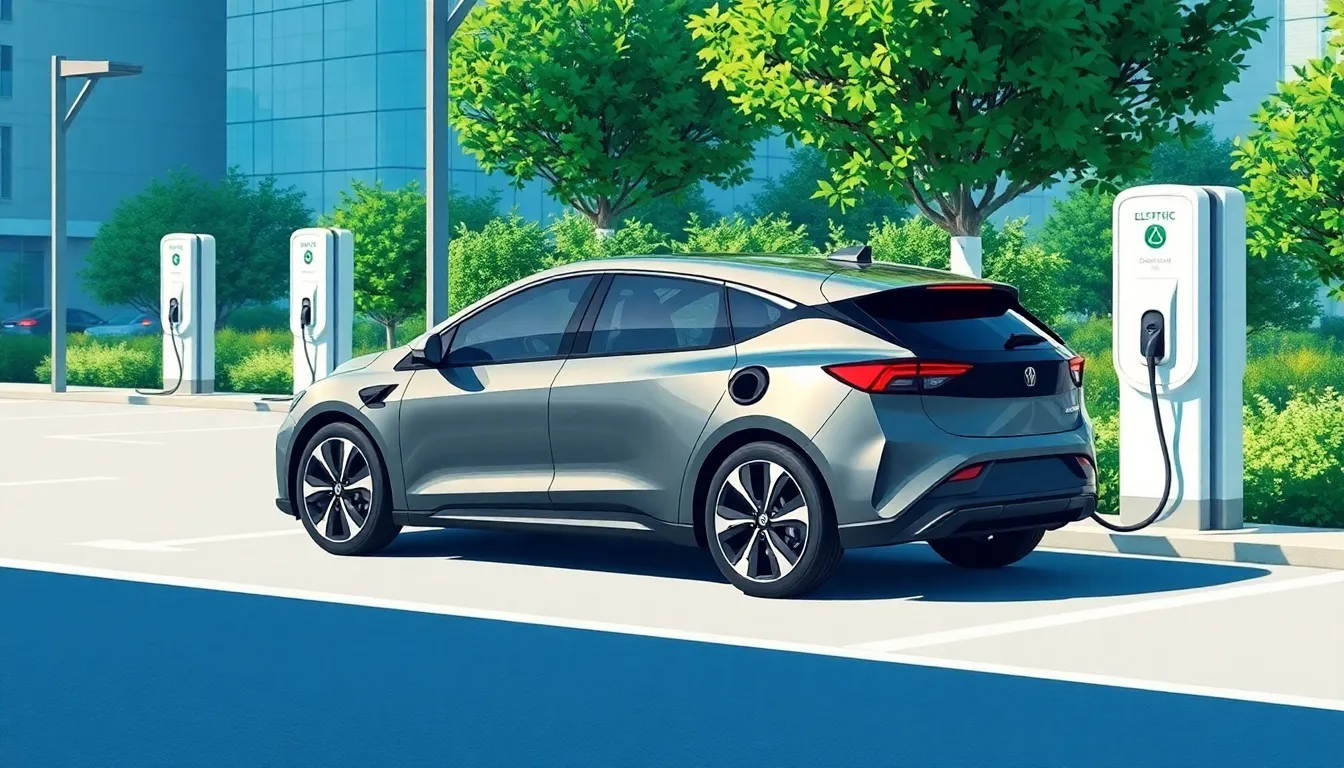In 2020, electric vehicles zoomed into the spotlight like a superhero at a surprise party. With the world grappling with climate change and fossil fuel dependence, EVs offered a glimmer of hope and a dash of excitement. Who wouldn’t want to ditch the gas station for a quick charge while sipping a latte?
As the automotive industry shifted gears, manufacturers unveiled sleek designs and jaw-dropping tech that made drivers rethink their traditional rides. The future was here, and it was whisper-quiet, emissions-free, and, let’s face it, pretty cool. From eco-conscious commuters to tech-savvy enthusiasts, electric vehicles captured hearts and paved the way for a greener tomorrow. Buckle up as we explore the electrifying journey of EVs in 2020, where innovation met sustainability in a thrilling race toward a cleaner planet.
Table of Contents
ToggleOverview of Electric Vehicles 2020
Electric vehicles (EVs) gained significant traction in 2020, appealing to a broader audience due to rising environmental awareness. Consumers focused on sustainability found EVs to be a compelling alternative to traditional gasoline vehicles. With advancements in battery technology, several EV models offered impressive ranges and quicker charging times.
Governments around the world implemented incentives to encourage EV adoption, leading to increased sales figures. Several countries reported record growth in EV registrations, demonstrating a strong consumer shift toward greener options. Major automakers unveiled numerous electric models, showcasing stylish designs and innovative features that attracted tech-savvy buyers.
Many manufacturers integrated cutting-edge technology, enhancing the driving experience with features like autonomous driving and smart connectivity. Industry experts noted that the growing charging infrastructure further propelled consumer confidence in switching to EVs.
In 2020, the presence of electric vehicles in urban environments became more visible, as cities focused on reducing carbon emissions. Enthusiasts joined communities to share tips, experiences, and charging station locations. Environmental organizations recognized the potential impact of EVs on achieving global climate goals, supporting policies that promote sustainable transportation.
EV sales statistics reflected optimism in the market, with some regions reporting double-digit growth. Analysts forecasted continued advancements in technology would drive further expansion of the EV market in the coming years. Overall, 2020 marked a pivotal year for electric vehicles, highlighting their role in shaping a sustainable automotive future.
Key Developments

2020 showcased significant advancements in the electric vehicle landscape, highlighting critical innovations and supportive policies.
Technological Advancements
Battery technology made remarkable strides, enhancing electric vehicle performance. Manufacturers achieved greater energy density, resulting in longer driving ranges, with many models exceeding 300 miles on a single charge. Quick charging stations became more prevalent, allowing drivers to recharge in under 30 minutes. Automakers integrated advanced features like autonomous driving capabilities, making EVs attractive to tech-savvy consumers. Emphasizing sustainability, manufacturers also focused on using eco-friendly materials in vehicle production. These technological enhancements positioned electric vehicles as highly functional, appealing choices in the automotive market.
Government Incentives
Governments implemented various incentives to encourage electric vehicle adoption. Tax credits offered consumers substantial savings on their purchases, with rebates averaging $7,500 in the United States. Many states provided additional incentives, including access to carpool lanes and reduced registration fees. These financial perks significantly impacted EV sales, with registrations reaching record highs. Public charging infrastructure investments also surged, with cities installing thousands of charging stations nationwide. Together, these incentives empowered consumers to make sustainable choices, boosting market growth for electric vehicles.
Popular Electric Vehicle Models
Electric vehicles gained popularity in 2020, with various models appealing to a wide range of consumers. The diversity of options showcased innovation in the EV market.
Tesla Models
Tesla led the EV revolution, offering sleek and high-performing vehicles. The Model 3, known for its affordability, captured the attention of consumers with a price point starting at around $39,990. Range capabilities reached over 350 miles, and it included features like Autopilot. The Model S represented luxury, offering up to 405 miles of range and impressive acceleration. Additionally, the Model X provided versatility with its spacious interior and advanced safety features. The Model Y entered the compact SUV segment, making it a suitable choice for families, with a targeted range of 300 miles.
Non-Tesla Alternatives
Several automakers produced compelling electric vehicles that catered to diverse preferences. The Chevrolet Bolt EV, priced around $36,500, provided a range of approximately 259 miles, appealing to budget-minded consumers. The Ford Mustang Mach-E emerged as a stylish electric SUV, combining sporty design with a range of about 300 miles. BMW released the i3 and i4 models, focusing on performance and luxury. Hyundai presented the Kona Electric, a compact SUV that delivered around 258 miles of range and practicality. Nissan’s Leaf continued to be a reliable choice, offering affordability and a range of about 226 miles.
Market Trends
Electric vehicles (EVs) experienced remarkable growth in 2020, capturing significant consumer interest and reshaping the automotive landscape.
Consumer Adoption
Consumers increased their interest in EVs due to environmental benefits and advanced technology features. Approximately 1.8 million electric vehicles were sold globally in 2020, marking a 43% increase compared to 2019. Factors driving this momentum included lower running costs and improved charging infrastructure. Tesla models, particularly the Model 3, topped sales, appealing to budget-conscious buyers seeking electric alternatives. As the year progressed, conventional automakers also expanded their EV offerings, enhancing options for various consumer preferences. Several utility companies provided incentives for EV charging, making ownership more attractive. Enthusiast communities played a vital role, sharing experiences and insights that further encouraged adoption.
Environmental Impact
Environmental considerations significantly influenced EV popularity in 2020. Electric vehicles produce fewer emissions compared to traditional gasoline cars, contributing to improved air quality. Research indicates that replacing internal combustion engine (ICE) vehicles with EVs can reduce greenhouse gas emissions by up to 70% over their lifecycle. Cities expanded their charging networks to promote cleaner transportation options. In 2020, U.S. policymakers implemented regulations encouraging EV adoption, aiming to reach ambitious emission reduction targets. Additionally, widespread consumer awareness of climate change propelled demand for sustainable solutions. The shift toward electric transportation resulted in a noticeable decrease in urban carbon footprints, fostering a healthier environment.
Challenges Facing Electric Vehicles
Several challenges continue to hinder the widespread adoption of electric vehicles. Two critical areas include charging infrastructure and battery technology.
Charging Infrastructure
Charging infrastructure remains a significant hurdle for electric vehicle adoption. Urban areas need more charging stations to support an increasing number of EVs. Consumers often face range anxiety, worrying about access to charging points during long trips. Fast-charging stations must multiply to offer quick recharges for those on the go. Public charging networks require substantial investment and coordination among governments and private companies. As a result, initiatives promoting the installation of charging stations are essential to alleviate concerns and enhance accessibility.
Battery Technology
Battery technology plays a vital role in the performance of electric vehicles. While advancements occurred, range limitations still affect consumer confidence. Many EVs currently offer ranges over 300 miles, but some drivers desire longer distances without frequent recharges. Charging speed improvements remain essential, as many consumers expect quick turnaround times for battery replenishment. Additionally, the lifecycle environmental impact of battery production raises concerns about sustainability. Innovations in battery materials and recycling processes could address these issues, paving the way for more efficient and eco-friendly options in the future.
The electric vehicle landscape in 2020 marked a pivotal moment in the shift toward sustainable transportation. With technological advancements and increased consumer interest EVs became a mainstream choice for many. The combination of sleek designs improved performance and environmental benefits captured the attention of diverse buyers.
As cities expand charging infrastructure and governments promote supportive policies the future of electric vehicles looks promising. Continued innovation in battery technology and charging solutions will likely address current challenges and enhance consumer confidence. The growing enthusiasm for EVs not only reflects a commitment to reducing carbon footprints but also signals a transformative shift in the automotive industry.
